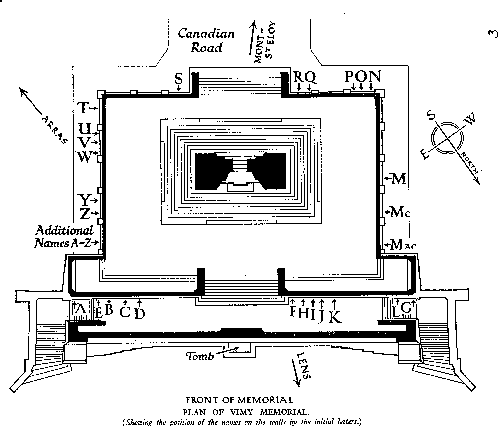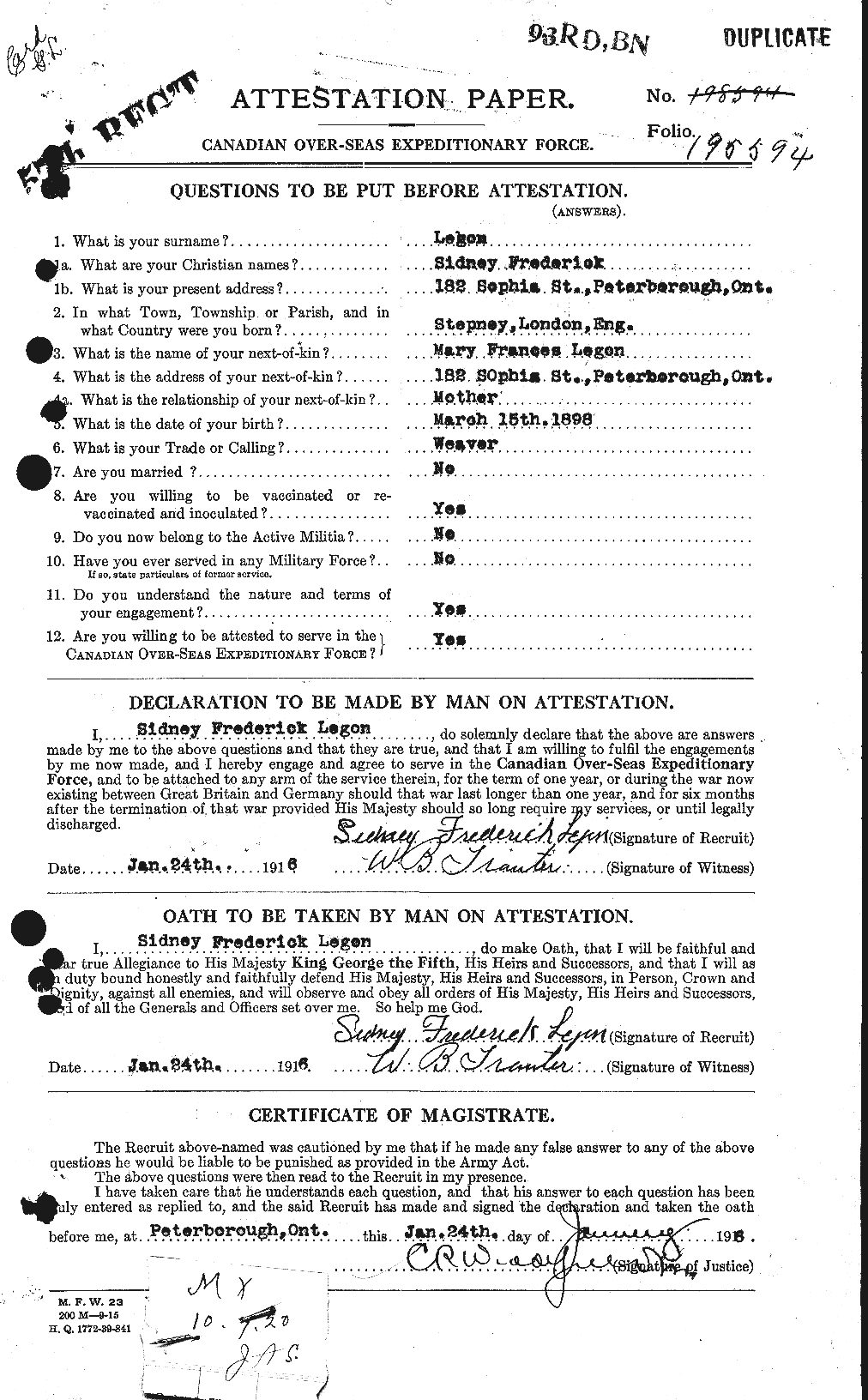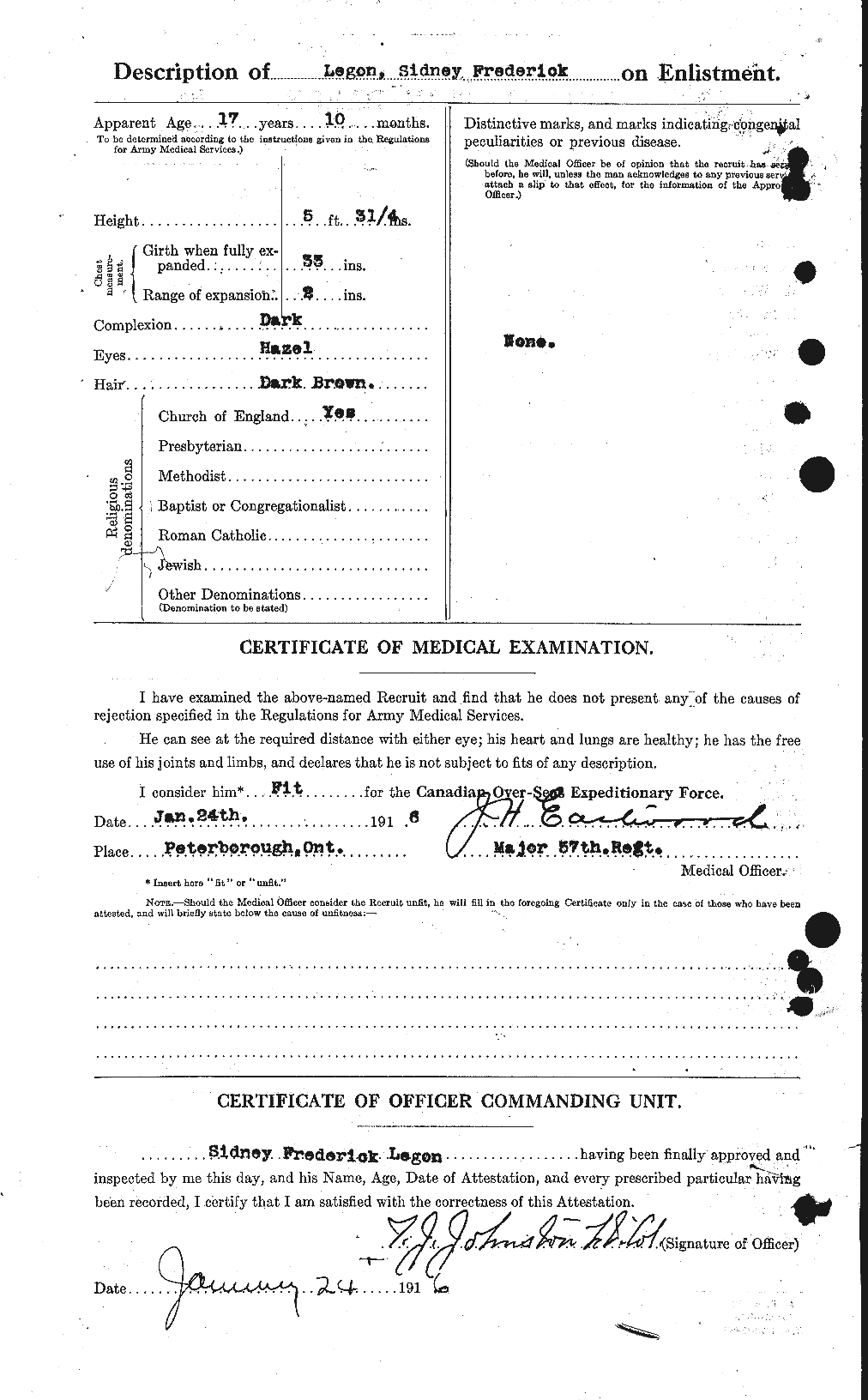


Sidney frederick Legon
Sidney Frederick Legon
Local Peterborough World War One hero, Sidney Frederick Legon, gave his life so that generations of Canadians could enjoy freedom. He was born on March 15, 1898 in Stepney, London, England. He immigrated to Canada as a young child and moved to 182 Sophia Street in East City, Peterborough, Ontario. As a young man he was 5 ft, 4 inches tall and only 115 pounds. He had a dark complexion, hazel eyes and dark brown hair. He was Anglican and a member of the Church of England. Sidney was a weaver by trade.
Sidney was just seventeen when he enlisted to join thousands of young Canadian men to fight alongside the British, Russian and French to defeat the Germans and Austria-Hungarians. He had his medical examination on January 24, 1916 and was declared fit for service although underage.
Sidney sailed from Halifax to Great Britain on the ship Per. Empress of Britain on July 15, 1916. His unit was the Canadian Infantry Eastern Ontario Regiment. He began with the Second Battalion, then spent some time with the 93rd Battalion before returning to the Second Battalion. He was a private earning $15 a month. He was based in Hastings and Seaford in Southern England until March 23, 1917. Sidney then crossed the English Channel to Northern France where fighting raged. Records indicate that he was killed in action on May 3, 1917 and is buried in an unmarked grave. It is possible that he was killed in the Battle of Arras, Third Battle of Scarpe which took place on May 3rd and 4th, 1917. All his money and personal possessions were left, according to his will, to his mother Mary Frances Legon and sent to the Sophia Street home. He is remembered at the Vimy Memorial located at Pas de Calais, France.

A letter in response from the next of kin, mother, Mary Frances Legon to Sidney


Cemetery Plan Vimy Plan
Underage Soldiers
-were caught up in patriotic fervour and answered call for King and Country, excited and assumed they would come home in time for Christmas
-roughly 20,000 underage Canadian soldiers in World War One and 2, 200 of them were killed
- often recruiting officers didn't ask for proof of age
- January 1917, the government ordered boys under 16 1/2 to return home to Canada, those 16 1/2 to 18 were pulled from the front and put in Young Soldiers Battalion (YSB)
-it was mothers who were most upset about underage soldiers
-these boys were forced into manhood very quickly
The Life of a Private in Training
-trained for 3 months
5:30am- trumpet (Reveille)
6:30am- fitness parade for 1 1/2 hour
8:00am- breakfast,
9:00am- morning drills such as
forming fours and about turn
12:15-2:00pm- lunch
2:00-4:15pm- more drills such as marchhing
evening- cleaning kit, shining boots, occasionally
go to the leisure center for billiards and reading
- after a few weeks of this, training became more advanced,
soldiers learned about the movements in the field, night
operations and route marching
- later learned how to handle weapons, marksmanship
and digging trenches
- the next stage was months of specialist training to
for a specific job such as a machine gunner, a signaller
or a cook

First World War Book of Rememberance



Stepney, London England

Sidney's Peterborough Home, 182 Sophia Street.

A letter written from Sidney to his next of kin, mother, Mary Frances Legon
The Green Fields of France
By Eric Bogle
Well how do you young Willie McBride,
Do you mind if I sit here by down your graveside,
And rest for a while 'neath the warmer summer sun,
I've been walking all day and I'm nearly done.
I see by your gravestone you are only nineteen,
When you joined the great fallen in 1916.
I hope you died well and I hope you died clean,
Ah young Willie McBride was it slow and unseen.
Did they beat the drum slowly
Did they play the fife lowly,
Did they sound the death march as they lowered you down?
Did the band play the Last Post and chorus,
Did the pipes play the Flowers of the Forest?
Did you leave a wife or a sweetheart behind
In some faithful heart is your memory engraved?
Although you died back in 1916
In that faithful heart you are forever 19?
Or are you a stranger without even a name
Enclosed forever behind a glass frame
In an old photograph, torn, battered and stained,
And faded to yellow in a brown leather frame.
The sun now it shines on the green fields of France
There's a warm summer breeze, it makes the red poppies dance,
And look how the sun shines from under the clouds,
There's no gas, no barbed wire, no gun firing now,
But here in this graveyard it's still no man's land.
The countless white crosses stand mute in the sand.
To a man's blind indifference to his fellow man,
To a whole generation that were butchered and damned.
Ah young Willie McBride, I can help wondering why
Do those that lie here know why did they die?
And did they believe when they answered the call,
Did they really believe that this war would end war?
For the sorrow, the suffering, the glory, the pain,
The killing and dying was all done in vain,
For young Willie McBride, it all happened again,
And again, and again, and again, and again.
The Battle of Arras
The Green Fields of France

Like "Willie McBride", Sidney was one of
thousands of young men who answered the call to join the Great War and is also
buried in an unmarked grave.
War propaganda in Canada
encouraged people to ration food.